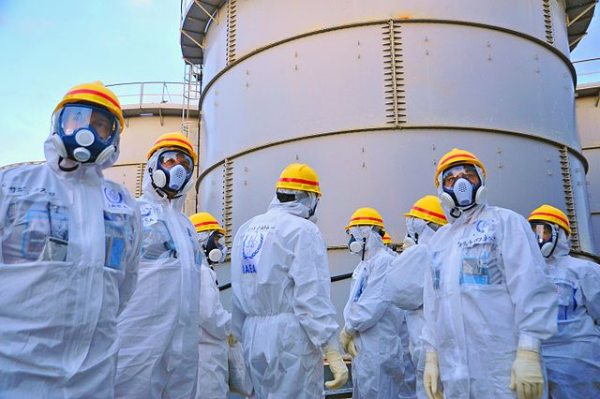7 February 2024 | Telesur
The Japanese plant has been generating a massive amount of water tainted with radioactive substances from cooling down the nuclear fuel in the reactor buildings.
On Wednesday, Fukushima Central Television reported that approximately 5.5 tons of water containing radioactive materials have leaked from an equipment at Japan's Fukushima Daiichi nuclear power plant.
At about 8:53 a.m., workers discovered water leaking from the outlet of a device used to purify nuclear-contaminated water during the inspection of the equipment, the local TV reported, citing the plant's operator Tokyo Electric Power Company (TEPCO).
The amount of water that leaked was approximately 5.5 tons, which may contain 22 billion becquerels of radioactive materials such as cesium and strontium.
Most of the leaked water appeared to have seeped into the soil, but monitoring of a nearby drainage channel did not show any significant radiation level changes.TEPCO has made the area where the water was leaked a no-go area.
Hit by a 9.0-magnitude earthquake and an ensuing tsunami in 2011, the Fukushima nuclear plant suffered core meltdowns that released radiation, resulting in a level-7 nuclear accident, the highest on the International Nuclear and Radiological Event Scale.
The plant has been generating a massive amount of water tainted with radioactive substances from cooling down the nuclear fuel in the reactor buildings, which are now being stored in tanks at the nuclear plant.
In August 2023, Japan started to discharge the Fukushima wastewater into the Pacific Ocean, despite numerous and repeated objections by governments and communities, environmental groups, NGOs and anti-nuclear movements.
8 February 2024 | TASS
Radioactive Water From Japan’s Fukushima-1 Not Seen Accumulating in Ice — Scientists
The agency added that following the leak, it did not bolster radiation controls.
VLADIVOSTOK, February 8. /TASS/. Radioactive water from the Fukushima-1 Nuclear Power Plant (NPP) will not turn into ice nor accumulate in a frozen state in the Pacific Ocean, the press service of the Far Eastern Primorye Meteorological Center told TASS, citing oceanographic researchers.
On February 7, employees of the Fukushima NPP detected a radioactive water leak on the premises of the nuclear facility. According to the Asahi newspaper, 5.5 tons of water leaked out. The concentration of radioactive substances in the leaked water amounts to 22 bln becquerels, which is 14 bln times above the norm, with 1,500 becquerels being the maximum allowable limit.
"The Fukushima-1 power plant is located near the town of Okuma on Japan’s east coast, where, thanks to the warm Kuroshio current, among other things, the average annual temperature is above 12 degrees Centigrade. Even during January, the coldest month, it does not drop below one degree above zero. Therefore, according to our ocean scientists, no ice is being formed there at all. As for the currents, the water from that area does not flow north, which also rules out its accumulation in the ice," the press service said, replying to a question from TASS.
The agency added that following the leak, it did not bolster radiation controls. Specialists have not registered any increases in radiation background, which is measured automatically once every hour.
Earlier, Russia’s consumer rights watchdog reported that no instances of the allowable limits of radioactive substances being exceeded following the Fukushima leak had been detected. The agency’s experts continuously screen every batch of fish and other seafood products brought into Russia for radiation safety.
Contaminated Water Leak Uncovered at Fukushima Nuclear Plant - Reports
8 February 2024 | Sputnik
TOKYO (Sputnik) - Tokyo Electric Power Company (TEPCO), the operator of the Fukushima nuclear power plant (NPP), said that there was a leak of contaminated water from radioactive water treatment equipment, Fukushima Central Television (FCT) reported on Wednesday.
The leak was detected by a station employee at 9:00 local time (0:00 GMT) on Wednesday during the inspection of the equipment. The employee found that 10 of the 16 valves of the station that should have been closed were open.
TEPCO estimated that the volume of water is 5.5 tonnes, it contains radionuclides, including radioactive cesium and strontium, and the content of radioactive substances is estimated at 22 billion becquerels. A significant part of the water has been presumably absorbed into the soil. A monitoring point installed next to a nearby sewage channel does not show radiation levels changes.
The leak occurred in the zone of alienation, work will be carried out to remove the soil into which the water has been absorbed, TEPCO said.
Fukushima Radioactive Water Leakage Accident Once Again Demonstrates TEPCO Management Disorder: Chinese FM
8 February 2024 | Global Times
The accident in Fukushima once again demonstrates the deep-rooted problems of disorder and chaos in the internal management of Japan's Tokyo Electric Power Company (TEPCO). Meanwhile, Japan has the responsibility to promptly and fully disclose information about the incident in a transparent manner and provide responsible explanations, said Chinese Foreign Ministry spokesperson Wang Wenbin on Thursday, after Japanese media reported that 5.5 tons of water containing radioactive materials have leaked from an equipment at Japan's Fukushima Daiichi nuclear power plant.
Japan's plan to discharge Fukushima nuclear-contaminated water into the sea is expected to last for 30 years or even longer. "Can the Japanese government ensure safety and reliability in future emission management? Can the Fukushima nuclear-contaminated water purification system and ocean discharge facilities operate stably and effectively in the long term? We have reasons to be concerned and have doubts about it," Wang said.
TEPCO estimated that the amount of water that leaked was approximately 5.5 tons, which may contain 22 billion becquerels of radioactive materials such as cesium and strontium, according to the Xinhua News Agency, citing local media reports.
The water was assessed to have leaked from a valve left open during cleaning work at the absorption tower, according to a release by the International Atomic Energy Agency (IAEA).
The accident once again highlights the necessity and importance of establishing a long-term effective international monitoring arrangement, Wang said. China urges Japan to respond to the concerns of the international community with a responsible attitude, and dispose of nuclear-contaminated water in a responsible manner.
China also called for Japan to fully cooperate in establishing independent and effective long-term international monitoring arrangements involving the participation of neighboring countries and other stakeholders, and effectively prevent irreversible consequences caused by the discharge, according to Wang.
On the same day, a spokesperson from the Chinese Embassy in Japan also said that the incident exposed the ineffective supervision measures by the Japanese government. This "once again" proves the lack of the long-term reliability of the nuclear-contaminated water treatment system, highlighting the necessity for international supervision, said the spokesperson.
China will closely monitor the subsequent impact of the accident and hope that Japan will promptly disclose relevant information, the spokesperson noted.
Dumping the nuclear-contaminated water is related to the health of all mankind, the global marine environment, and international public interests, the spokesperson noted.
Japan started dumping nuclear-contaminated water from the crippled Fukushima Daiichi nuclear power plant into the Pacific Ocean in August 2023, despite facing opposition and concerns from local fishermen and other countries.
TEPCO has unveiled a plan to release approximately 54,600 tons of nuclear-contaminated water from its facility into the ocean during the fiscal year 2024
Fukushima Leak Exposes Failures in Nuclear Crisis Management
8 February 2024 | Telesur
It is estimated that 22 billion becquerels of radioactive materials such as cesium and strontium are contained in the leaked water.
In a chilling revelation that sent shockwaves through the world, a new nuclear waste leak has unearthed the gaping crack in Japan's professed claim of responsible handling the accident at the Fukushima Daiichi nuclear power plant.
The leakage of about 5.5 tons of water containing radioactive materials from the plant also highlights the need for international supervision of Japan's controversial discharge of the Fukushima nuclear-contaminated water into the ocean.
It is estimated that 22 billion becquerels of radioactive materials such as cesium and strontium are contained in the leaked water, and the plant's operator, Tokyo Electric Power Company (TEPCO), claimed on Wednesday that monitoring of a nearby drainage channel did not show any significant radiation level changes.
This begs the question: What constitutes a "significant" level? Nearly 13 years after the catastrophic earthquake and tsunami, recurring leaking incidents still hint at the utility's mismanagement and the Japanese government's inadequacy in overseeing it.
On Oct. 26, 2023, just one week before Japan started the third round of release, two men were hospitalized after being accidentally splashed with radioactive liquid at the plant. On Aug. 11, 2023, days before the first round of discharge started, TEPCO found leaks in a hose used to transfer nuclear-contaminated water, which, as it said, would not affect the discharge plan.
Even more concerning, the causes of these incidents have fully exposed the chaos and disorder of TEPCO's internal management. The leak on Wednesday stemmed from a valve left open during cleaning operations, while the October incident resulted from a loose hose channeling contaminated solutions.
In August, TEPCO attributed a leak to cracks approximately four centimeters in length found in a hose. The deficiencies in the fundamental equipment raise questions about the potential for similar occurrences and whether TEPCO conducts regular inspections of its equipment.
While TEPCO this time claimed that there is no risk to the public and that the surrounding environment remains unaffected by the leak, its history of cover-ups and opacity has eroded public trust.
For instance, it took TEPCO over two years after the 2011 tsunami to acknowledge that radioactive tritium had leaked into the Pacific Ocean, contradicting its initial assertions that the toxic water had been contained within the plant's premises.
In February 2015, TEPCO admitted that since April 2014, it had been aware of radioactive substances from a rainwater drainage ditch linked to one of its buildings being leaked into the sea when it rained.
Until meaningful reforms are enacted, the specter of Fukushima will continue to haunt Japan, serving as a sober reminder of the country's failure to protect its citizens and the broader environment.
"Each of these brief articles seemed to add a bit to the picture. ~ Ed."



















